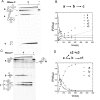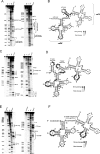Distributive enzyme binding controlled by local RNA context results in 3' to 5' directional processing of dicistronic tRNA precursors by Escherichia coli ribonuclease P
- PMID: 30496557
- PMCID: PMC6379654
- DOI: 10.1093/nar/gky1162
Distributive enzyme binding controlled by local RNA context results in 3' to 5' directional processing of dicistronic tRNA precursors by Escherichia coli ribonuclease P
Abstract
RNA processing by ribonucleases and RNA modifying enzymes often involves sequential reactions of the same enzyme on a single precursor transcript. In Escherichia coli, processing of polycistronic tRNA precursors involves separation into individual pre-tRNAs by one of several ribonucleases followed by 5' end maturation by ribonuclease P. A notable exception are valine and lysine tRNAs encoded by three polycistronic precursors that follow a recently discovered pathway involving initial 3' to 5' directional processing by RNase P. Here, we show that the dicistronic precursor containing tRNAvalV and tRNAvalW undergoes accurate and efficient 3' to 5' directional processing by RNase P in vitro. Kinetic analyses reveal a distributive mechanism involving dissociation of the enzyme between the two cleavage steps. Directional processing is maintained despite swapping or duplicating the two tRNAs consistent with inhibition of processing by 3' trailer sequences. Structure-function studies identify a stem-loop in 5' leader of tRNAvalV that inhibits RNase P cleavage and further enforces directional processing. The results demonstrate that directional processing is an intrinsic property of RNase P and show how RNA sequence and structure context can modulate reaction rates in order to direct precursors along specific pathways.
Published by Oxford University Press on behalf of Nucleic Acids Research 2018.
Figures










Similar articles
-
The rph-1-Encoded Truncated RNase PH Protein Inhibits RNase P Maturation of Pre-tRNAs with Short Leader Sequences in the Absence of RppH.J Bacteriol. 2017 Oct 17;199(22):e00301-17. doi: 10.1128/JB.00301-17. Print 2017 Nov 15. J Bacteriol. 2017. PMID: 28808133 Free PMC article.
-
Ribonuclease P processes polycistronic tRNA transcripts in Escherichia coli independent of ribonuclease E.Nucleic Acids Res. 2007;35(22):7614-25. doi: 10.1093/nar/gkm917. Epub 2007 Nov 2. Nucleic Acids Res. 2007. PMID: 17981836 Free PMC article.
-
Processing of the seven valine tRNAs in Escherichia coli involves novel features of RNase P.Nucleic Acids Res. 2014;42(17):11166-79. doi: 10.1093/nar/gku758. Epub 2014 Sep 2. Nucleic Acids Res. 2014. PMID: 25183518 Free PMC article.
-
The specificity landscape of bacterial ribonuclease P.J Biol Chem. 2024 Jan;300(1):105498. doi: 10.1016/j.jbc.2023.105498. Epub 2023 Nov 25. J Biol Chem. 2024. PMID: 38013087 Free PMC article. Review.
-
Coordination of transcription and processing of tRNA.FEBS J. 2022 Jul;289(13):3630-3641. doi: 10.1111/febs.15904. Epub 2021 May 11. FEBS J. 2022. PMID: 33929081 Review.
Cited by
-
Regulation of mRNA decay in E. coli.Crit Rev Biochem Mol Biol. 2022 Feb;57(1):48-72. doi: 10.1080/10409238.2021.1968784. Epub 2021 Sep 21. Crit Rev Biochem Mol Biol. 2022. PMID: 34547957 Free PMC article.
-
Inactivation of RNase P in Escherichia coli significantly changes post-transcriptional RNA metabolism.Mol Microbiol. 2022 Jan;117(1):121-142. doi: 10.1111/mmi.14808. Epub 2021 Sep 25. Mol Microbiol. 2022. PMID: 34486768 Free PMC article.
-
Structural and mechanistic basis for recognition of alternative tRNA precursor substrates by bacterial ribonuclease P.Nat Commun. 2022 Aug 31;13(1):5120. doi: 10.1038/s41467-022-32843-7. Nat Commun. 2022. PMID: 36045135 Free PMC article.
References
-
- Blattner F.R., Plunkett G. 3rd, Bloch C.A., Perna N.T., Burland V., Riley M., Collado-Vides J., Glasner J.D., Rode C.K., Mayhew G.F. et al. . The complete genome sequence of Escherichia coli K-12. Science. 1997; 277:1453–1462. - PubMed
-
- Li Z., Deutscher M.P.. Maturation pathways for E. coli tRNA precursors: a random multienzyme process in vivo. Cell. 1996; 86:503–512. - PubMed
Publication types
MeSH terms
Substances
Grants and funding
LinkOut - more resources
Full Text Sources

